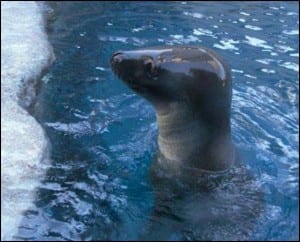Specimen of the Week: Week Five
By Emma-Louise Nicholls, on 14 November 2011
 As winter attempts quite convincingly to chill our doors, I thought I’d turn our attention down south and feature a mammal from the Antarctic. The first mammal to be featured in Specimen of the Week (pretty exciting stuff I know you’ll agree) this week’s specimen of the week is…
As winter attempts quite convincingly to chill our doors, I thought I’d turn our attention down south and feature a mammal from the Antarctic. The first mammal to be featured in Specimen of the Week (pretty exciting stuff I know you’ll agree) this week’s specimen of the week is…
***!!!!The Leopard Seal!!!***
1) Fulfilling the same role in the Antarctic as polar bears do in the Arctic, leopard seals are formidable predators. At up to 3.5 m long and 500 kg in weight, and with large, powerful, penguin munching canines, you don’t really want to annoy one.
2) They are the only seal species in the world known to prey on other seals.
3) Despite their powerful jaws and seal slicing front teeth, around 50% of the leopard seal’s diet consists of krill. Their molars, which look curiously like mini versions of King Neptune’s trident, act as a sieve for filtering krill out of the water.
4) The only zoo in the world to have leopard seals is in Australia. Their keeper told me she has to wear the same uniform and hairstyle every day, else the seals become agitated. Although it is as famous for its sunshine as its tv soaps, Australia can receive torrential downpours. A raincoat is clearly thus the way forward, except when it makes your whiskered work colleagues try to eat you of course.
5) True seals cannot lift themselves up on their front flippers and, although agile and efficient swimmers in water, they are slow and cumbersome on land. Sea lions and fur seals on the other hand, or flipper, are very agile on land.
If you would like to make a suggestion for next week’s specimen, please add a comment below. If you would like to adopt a leopard seal, as a pretty darn exciting Christmas present for example, please get in touch with us at zoology.museum@ucl.ac.uk.
2 Responses to “Specimen of the Week: Week Five”
- 1
 Close
Close





Pufferfish